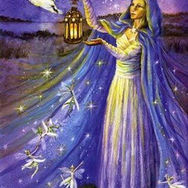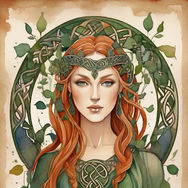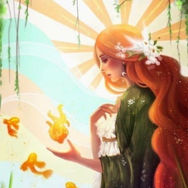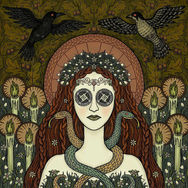















Celtic Wheel of the Year
The cross-quarter, fire festival of Imbolc, on the Celtic "Wheel of the Year," is traditionally celebrated beginning on the eve of February 1 (Feb. 2 in some locales) or celebrated according to the precisely timed astronomical and astrological date exactly between the Winter Solstice and the Vernal Equinox (the mid-point of winter; this year occurring on February 4). Imbolc is dedicated to the goddess Brigid or St. Bridget of Ireland.
The Irish name for February is Feabhra and the Anglo-Saxon name for this month was Solmonath (literally, “sun month”), noting the gradual return of the light after the darkness of midwinter.
February (Februarius) & Februa





"Lady February"
.jpg)

%201.jpg)
February is named after “Februa,” the Roman festival of purification, held on February 15. The print depicts Februa as a goddess in a shell, pouring water from a small jug. She is pulled along by two fish, which represent Pisces—the astrological sign which falls at the end of the month.
"Februa"
%201.jpg)
"Juno Februa"
%202.jpg)
"Juno Februa"
Thematic Images for Imbolc Blessings








Thematic Images for the Goddess of Imbolc, Brigid
Goddess of Poetry, Healing, and Smithcraft
Brigid (Brigit, Brighid) is a Celtic goddess celebrated annually on Imbolc, marking the beginning of spring. She is considered the patroness of poets and smiths, inspiring creativity and skill. She revered for her association with the arts, healing, and craftsmanship. Brigid’s connection to fire symbolizes destruction and purification, reflecting her role in transformation and renewal.


Brigid, goddess of poetry, music. and healing


Brigid, goddess of inspiration and creativity




Brigid of the Green Mantle





























.jpg)
Brigid (Seddon-Boulet)
.jpg)
Brigid (Art-Galaxy)
.jpg)
"Brigid, Celtic Goddess" (by Ibiza) could very well be inspired by the notion that Brigid may have at one time been the ancient Earth-Mother of the Celts. This is, for example, what Celtic folklorist Mara Freeman contends when she writes: "In fact, it might be said that Brigit is the nearest thing we have to a Great Mother of the Celts."
Thematic Images of Brigid as Bride of Scotland
.jpg)
"Bride"
.jpg)
"Coming of Bride" (Duncan)


Bride (or Brigid) is a beloved goddess of the Celts known by many names, Bride being the Scots Gaelic variant. According to legend, The Cailleach [kal-yukh], crone goddess of winter, is said to imprison Bride in a mountain each winter; She is released on the 1st of February, traditionally the first day of Spring in parts of the British Isles. And so winter gave way to spring, and then summer and autumn as Angus and Bride continued to rule, only for The Cailleach to rise again to reign over winter. And so the seasons came to pass upon Scotland.
Thematic Images of Brigid as the Triple-Goddess










In essence, Brigid embodies the concept of a triple goddess, meaning she is three deities in one with powers of poetry (the fire of the spirit), healing (the fire of life within), and smithcraft (physical fire without). The first two images in this picture panel depict Brigid as healing with water and fire.
Thematic Images of Brigid, The Fire-Goddess



Brigid, "The Flaming Arrow"

"Bringing the Imbolc Fire"










































Bridget’s or Brighid’s name means "the exalted one." These images show the pillar of flame that emanates from her head. Legend says that when She was born a tower of flame reached from the top of her head to the heavens.








Brigid is the goddess of art and inspiration, the patroness of womanly arts. She is said to inspire the creativity and artistry in blacksmiths. Because she is the goddess of both fire and inspiration, the poetic inspiration saying “fire in the head” came about.







Thematic Images of Brigid & The Fires of Love

Brigid & The Fire of Love

Brigid's Fire of Love


"The Passion of Bridgit"






Thematic Images of Brigid, The Sun-Goddess














Thematic Images of Brigid/St Brgid as Goddess of Sacred Waters & Holy Wells


.jpg)



%201.jpg)
%202.jpg)
%203.jpg)
St Brigid's Well (Kildare, Ireland). The Christian saint took over Brigid's role in presiding over many healing springs.
Thematic Images of Brigid's Cross



Brigid's cross is named for Brigid of Kildare, the only female patron saint of Ireland, who was born c. 450 in Leinster. Unlike her contemporary, Saint Patrick, Brigid left no historical record, and most information about her life and work derives from a hagiography written by the monk Cogitosus some 200 years after her birth. The prevailing Christian folklore surrounding Brigid's cross involves the deathbed conversion of an Irish pagan chieftain, in some stories her father. While telling the pagan about the Crucifixion of Jesus, Brigid collected rushes from the ground and wove them into a cross, after which the chieftain requested a Christian baptism. In another story, Brigid was given a poisoned drink by a woman of ill intent, and she wove the cross to neutralize the toxins.
( Wikipedia, "Brigid's Cross")
It should be kept in mind that this Christian folklore was designed to co-opt the popular status of goddess Brigid in order to convert the pagan people's of Ireland to Catholicism. (See next section, "The Goddess Brigid as St Brigid")
Many of the folk attributes ascribed to St Brigid of Kildare bear obvious similarities to the pagan grain goddess Brigid, and it is likely that the legends and rituals attributed to the goddess were later mapped onto the saint. In pre-Christian Ireland, 1 February, later Brigid of Kildare's feast day, was the date of the Imbolc festival, a holiday associated with agrarianism and the beginning of spring. It is therefore possible that diamonds and lozenges were Celtic symbols associated with Imbolc, and that Christian missionaries added arms to evoke the shape of a cross, appropriating these symbols with a Christian meaning and attributing them to the saint.
( Wikipedia, "Brigid's Cross")
Saint Brigid shares many of the goddess's attributes and her feast day, 1 February, was originally a pagan festival called Imbolc. It has thus been argued that the saint is a Christianization of the goddess, or that the lore of the goddess was transferred to her. . . .
Historians suggest that the goddess Brigid was syncretized with the Christian saint of the same name. According to medievalist Pamela Berger, Christian monks "took the ancient figure of the mother goddess and grafted her name and functions onto her Christian counterpart," Brigid of Kildare. The goddess and saint have many of the same associations. Saint Brigid is considered a patroness of healers, poets, blacksmiths, livestock and dairy workers, as well as serpents (in Scotland) and the arrival of spring.
(Wikipedia, "Brigid")


Thematic Images for the Goddess Brigid as St Brigid


.jpg)



.jpg)
"St Bride" (Duncan)

"St Brigid is one of the patron saints of Ireland. But the virgin nun has roots that go back to the days when the land’s pagan deities received prayers instead. It seems the Celtic goddess Brigid shares more than just a name with the saint. . . .
During the first centuries of its existence, the Christian religion adopted and modified many pagan sites and stories. Several churches replaced ancient altars and sacred pagan locations. Moreover, stories about the great people of the past and myths about their deities became the foundation for legends which describe the lives of Christian saints. When the early Christians discovered a powerful story in the land of a recently converted community they tried to replace it with one of their own. . . .
Her name is often said to be Brigid, but she has also been called Brigit, Brig, Brighid, Bride, etc. She was an ancient Irish goddess who was associated with spring, poetry, medicine, cattle, and arts and crafts. Brigid’s feast day was celebrated around February 1 and was called Oimlec (Imbolc). According to Cormac's Glossary (written by 10th century monks) she was a daughter of the god Dagda, a protector of a tribe. She was worshiped as a goddess of poetry, fertility, and smiths. Her identification with Minerva comes from the interest of both goddesses in bards and artists. . . .
When Ireland was Christianized, the monks and priests needed good examples to inspire people to follow the new faith. They used the same method as in the other parts of the world and started to create stories which sounded familiar to the inhabitants of the converted areas. In one of these stories they described a woman who connected the two cultures."
Thematic Memes for the Goddess Brigid
by the Gypsy Scholar













Thematic Images of The Imbolc Cailleach & The Triple Goddess Brigid


The Cailleach [kal-yukh] and Brigid are two aspects of the same goddess, their changing faces mirroring the changing of the seasons, and the way the Celts viewed theses seasonal cycles. At times these dual goddesses appear as a Crone and Maiden (as with the "Maiden-Mother-Crone" aspects of the triple goddess Brigid), at other times they are two sisters. In Scotland, the Old Woman of winter, the Cailleach is reborn as Bride, Young Maiden of Spring, fragile yet growing stronger each day as the sun rekindles its fire, turning scarcity into abundance. Imbolc is, in fact, the day the Cailleach — the "Hag" of Gaelic tradition — who gathers her firewood for the rest of the winter. Legend has it that if she intends to make the winter last a good while longer, she will make sure the weather on Imbolc is bright and sunny, so she can gather plenty of firewood. Therefore, people are generally relieved if Imbolc is a day of foul weather, as it means the Cailleach is asleep and winter is almost over.


Thematic Paintings of Imbolc & Brigid Themes

"Imbolc"


"Imbolc"

"Imbolc"
"Imbolc"

"Brigid Awakening"

"Brighid's Walk"
.jpg)
"Imbolc" (Clark)
.jpg)
"Imbolc Swan Maiden" (Andrew)

Brigid's Day Ritual

"Brigid of the Healing Waters"

"Brigid, Maiden and Crone"

Imbolc New Moon Ritual

"Brigid, Goddess of Fire, Poetry, and Healing"

"Brighid, Mother and Crone"

"Brighid's Day"
Thematic Images & Memes for Imbolc & the Return of Spring

"Imbolc Anticipation"
.jpg)
"Dreaming of Spring" (Andrew)
.jpg)
"Imbolc Celtic Spring" (Art Nouveau)





Gypsy Scholar

Gypsy Scholar



Goddess of Spring, Brigit
From the darkness to the light.
From the long cold winter and the empty nights.
Seasons change beneath our feet; time alone does not retreat.
At the first breath of spring birds follow her and begin to sing.
Where she walks flowers appear, birds hover close longing to be near.
The forest awakens and the grass turns green, this is the magic she brings.
She works in concert with the moon to bring back love in full bloom.
Frozen hearts melt at her first glance, allowing love, and then romance.
The world begins again a celebration of faith and hope we hold within.
~ S.V. Mastison

Music Video: "Bridget's Song"



































































































































































































































































.jpg)
